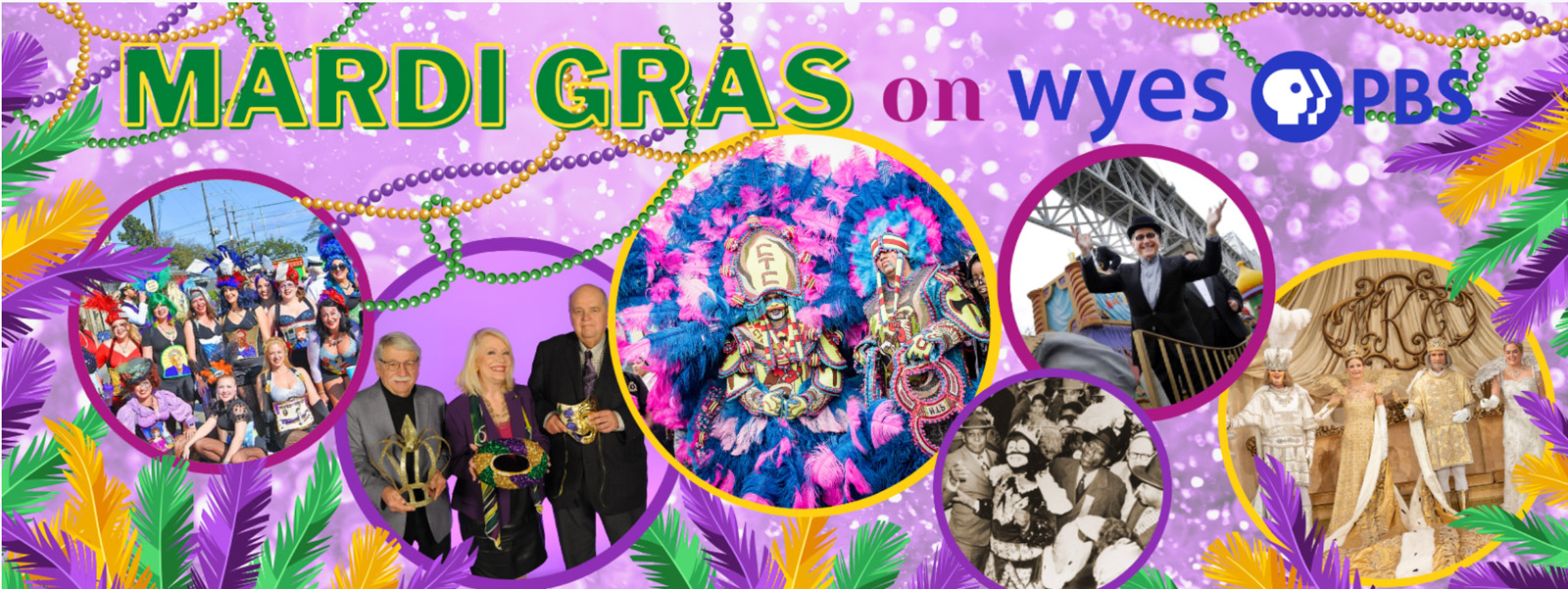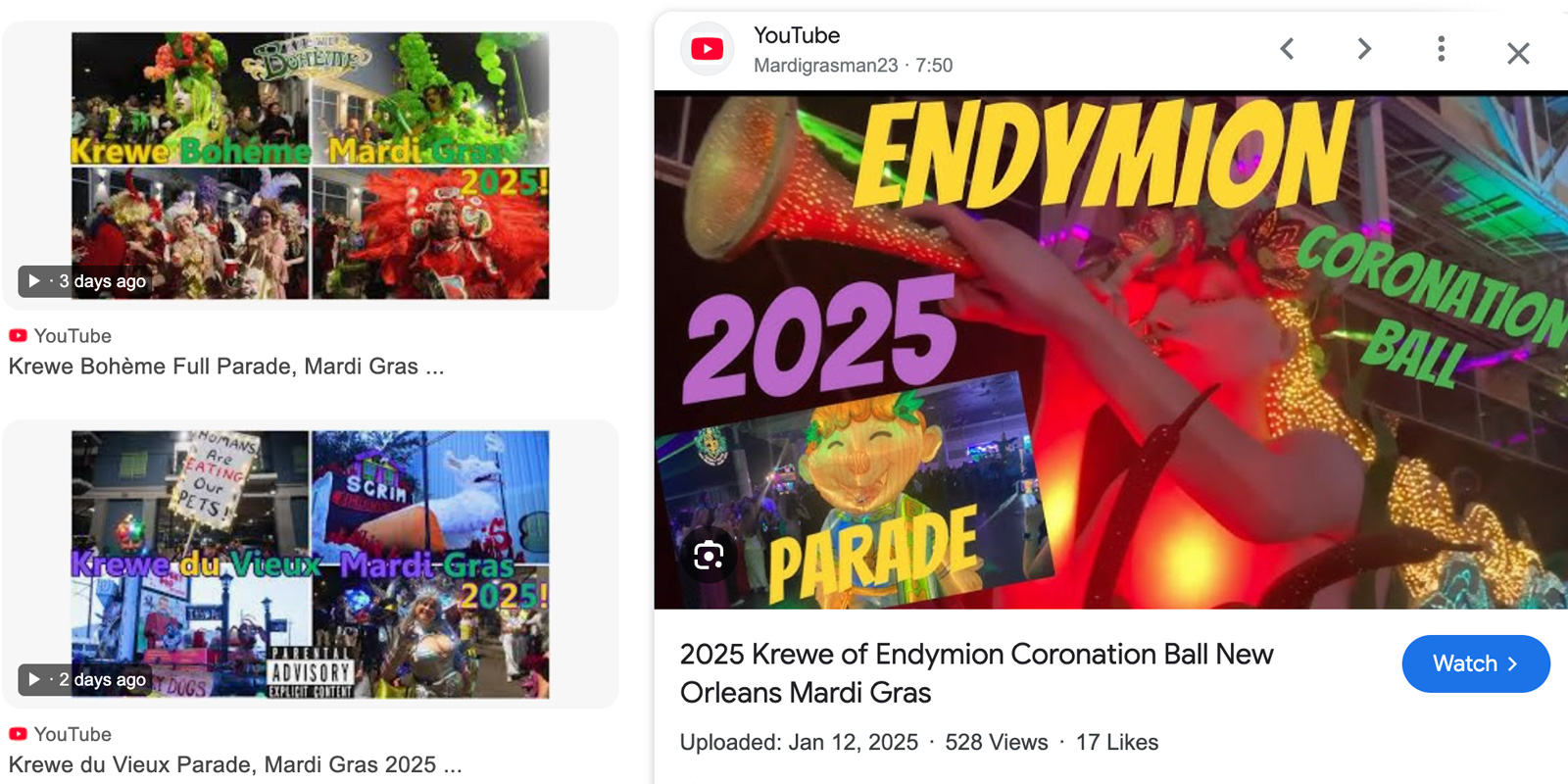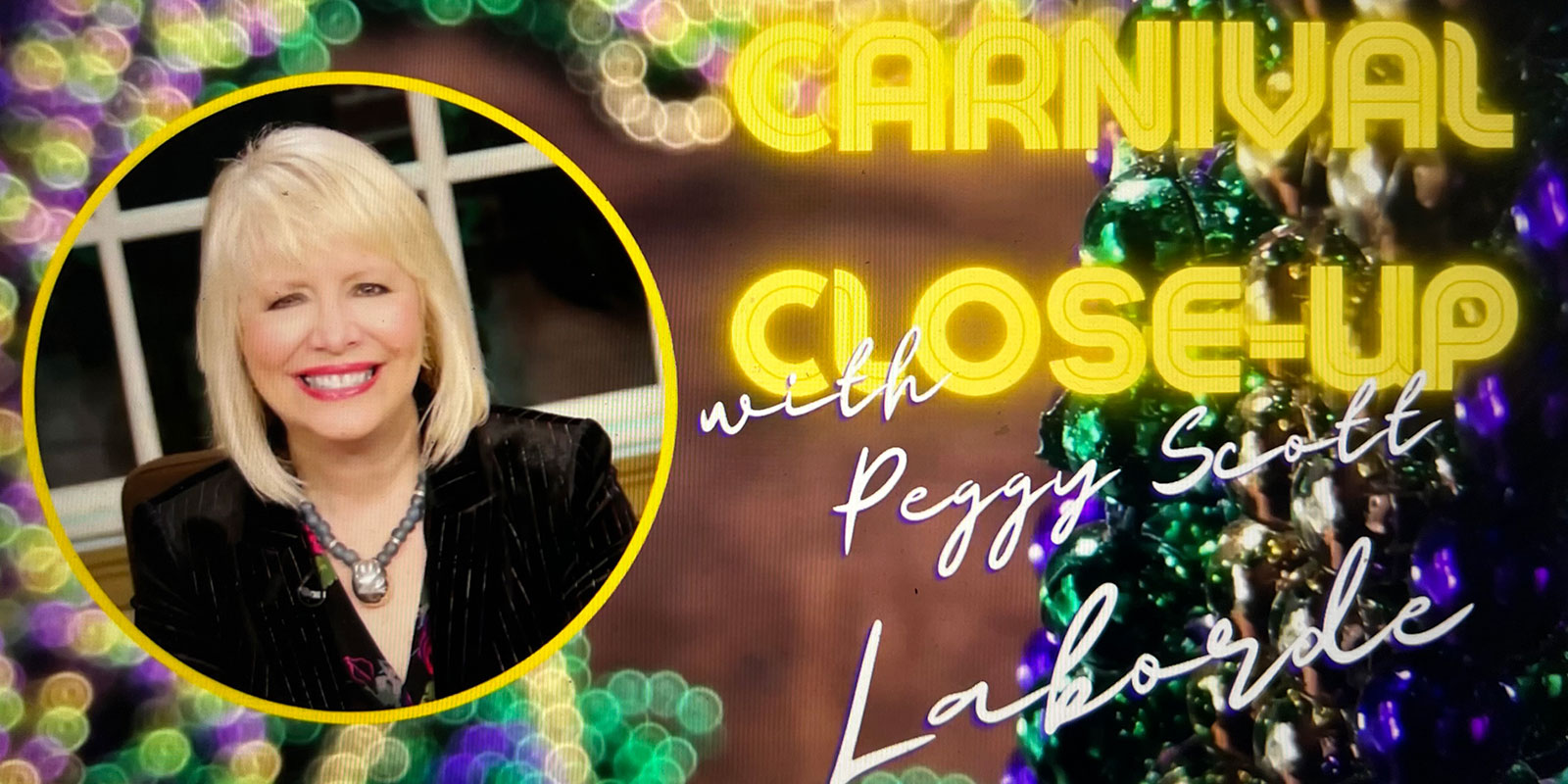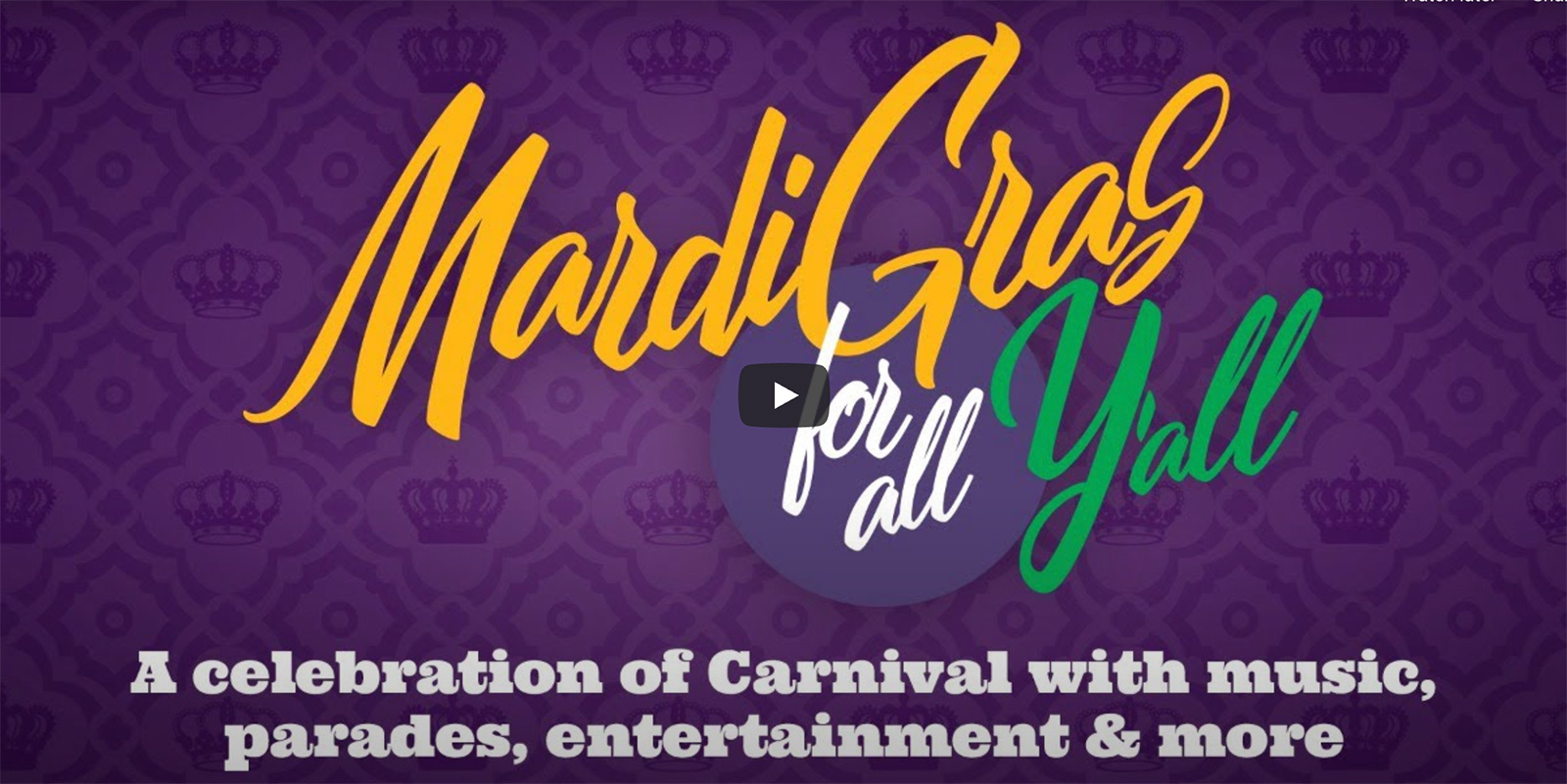Get your fix of Carnival kicks
Parades are streamed live by NOLA.com’s Parade Cam and WWL-TV’s Live Vue. Also, in any given year, local TV stations (WWL, WDSU and WVUE) might provide live coverage of events like the Endymion Samedi Gras Festival, the Zulu Lundi Gras Festival and the arrivals of Rex and Zulu along the Mississippi River on Lundi Gras (Fat Monday). Action on Bourbon Street is streamed continuously from a camera at The Cat’s Meow, at the corner of St. Peter Street. New Orleans PBS affiliate WYES can always be counted on to present (on air and online) an abundance of Mardi Gras programming (details below). If you can’t tune in live, generous helpings of on-demand Carnival fare are accessible on the stations’ websites and YouTube pages. WWL, WDSU and WVUE begin wall-to-wall live coverage of Fat Tuesday festivities before sunrise. The Guardians of the Groove, WWOZ, offers a feast of music and cultural programming (on air at 90.7 FM and streaming live), as well as via its website and YouTube page. In addition, “OZ” offers community event listings, podcasts, cultural news and a calendar of live music performances, while also occasionally presenting live event broadcasts and video streams. Stream Mardi Gras episodes, with interview segments and extensive playlists, from the archive of the American Routes radio program. And dive into the many permutations of the constantly evolving celebration with the Mardi Gras Beyond the Beads podcast, co-hosted by New Orleans Magazine editor in chief Errol Laborde and Rich Collins. Also noteworthy:
Mardi Gras on WYES
As the pre-Lenten season of frivolity kicks into gear, Steppin’ Out, WYES’ weekly program on New Orleans arts and entertainment stokes the Mardi Gras spirit with commentary, interviews and previews about what’s noteworthy and new. Its annual “It’s Carnival Time” edition, hosted by Peggy Scott Laborde along with Carnival historians Arthur Hardy and Errol Laborde, airs on Thursday, February 13 at 7:30 pm and repeats on Friday, February 14th at 11:30 pm; Saturday, February 15 at 5:30 pm; Sunday, February 16 at 10 am; Saturday, February 22 at 3 pm; Thursday, February 27 at 7 pm; and Friday, February 28 at 11 pm. On-demand episodes of Steppin’ Out, including recordings of “It’s Carnival Time” from previous years, are available on YouTube.
WYES is also the go-to outlet for an impressive parade of in-house and independently produced documentaries illuminating Mardi Gras in all its permutations. Its one-hour, Emmy-nominated program New Orleans Parades of the Past, hosted by Peggy Scott Laborde and produced by Dominic Massa, includes rare home movies and archival footage and is available on-demand on YouTube.
The follow up, More New Orleans Parades from the Past, airs on Monday, February 17 at 9 pm; Saturday, February 22 at 7 pm and Wednesday, February 26 at 10 pm. Peggy, Errol and Arthur return to present more rare home movie and archival footage from the past 85 years featuring Rex, Zulu, Proteus, Endymion, Bacchus, Thoth, Carrollton, Mid-City, NOMTOC, Argus, Venus and more. Also available on YouTube.
Beginning on Wednesday, January 22nd, WYES presents an extensive lineup of programs covering various aspects of Carnival including Big Chiefs of Carnival: The Spirit Moves my Needle, Big Queens of Carnival: It’s Your Glory, All on a Mardi Gras Day, While We Danced: The Music of Mardi Gras and Mardi Gras Floats from the Ground Up. Check out the complete schedule here.
WYES presents the 2025 Rex Ball and the Meeting of the Courts of Rex and the Mistick Krewe of Comus on Mardi Gras, March 4, at 7 pm, with a repeat showing at 11:30 pm. The program, hosted by Peggy, Errol and Rex historian Will French, also streams live via WYES.org/live, YouTube and the WYES and PBS apps. Watch recordings of past episodes on YouTube.
The Meeting of the Courts began in 1882 when the court of Rex paid a visit to the court of Comus at the French Opera House. The ornate proceedings culminate in a blaze of glittering scepters and other finery, as Rex and Comus escort each other’s queens in a grand march around the ballroom.
Mardi Gras on YouTube
YouTube offers an ever-expanding library of Mardi Gras video content — a rabbit hole deep enough to satisfy even the most ardent binge viewer. For starters, subscribe to the channels maintained on the platform by media outlets nola.com, WWL, WDSU, Fox 8 and WYES. Each have Mardi Gras portals on their websites, as well, for easy access to coverage and info relating to the festivities, including parade schedules and previews, reports on Carnival royalty and king cakes, plus interviews with practitioners of the Carnival arts and behind-the-scenes players. Find the portals here:
| nola.com | WWL | WDSU | Fox 8 | WYES |
Miss a favorite parade? No worries. Parades and other Mardi Gras events live-streamed on YouTube can be replayed on demand by entering, in the YouTube search bar, “2025 New Orleans Mardi Gras parades,” for instance.
Arthur Hardy, an encyclopedia of knowledge and insight about Mardi Gras, first made his name as a high school band director and then as publisher of the annual Arthur Hardy’s Mardi Gras Guide (2025 is the 49th edition). He’s also published books, including Mardi Gras in New Orleans: An Illustrated History (now in its fifth edition), and become a familiar presence across electronic media. An archive of some of his commentaries and reports can be found on his YouTube channel.
Another noteworthy Carnival destination on YouTube: The Historic New Orleans Collection, a museum, research center and publisher based in the French Quarter and focused on New Orleans and Gulf South history. Its video segments cover parade history and other elements of the holiday including Mardi Gras Indian Big Chiefs, the making of floats for the Rex parade and the history of the North Side Skull and Bone Gang.
Carnival Close-Up with Peggy Scott Laborde
WYES’ Peggy Scott Laborde presents weekly online vignettes on the station’s YouTube andFacebook pages highlighting treasures from her collection of Mardi Gras memorabilia. Items such as postcards, krewe favors and some trinkets hidden inside king cake, besides being highly collectable, offer insights into the history and traditions of Carnival as well as the historical roots and iconographies of individual krewes.
The custom of bestowing favors as gifts to ball or reception guests began in the early 1880s, typically in exchange for a dance – a custom known as a call-out. Intricately crafted, limited-edition favors such as pins, pendants and badges, many emblazoned with the krewe’s initials, were originally made in Germany. Laborde’s collection also includes more practical items such as a pin cushion from 1906, a tiny jewelry box from 1907 and a letter opener from 1910, all of which were given out by the Rex Organization.
Postcards depicting Mardi Gras on Canal Street offer clues into changing the dress and costuming habits of parade-goers. A rare postcard shared by Laborde shows King Zulu on his float after having arrived on a tugboat at the now filled-in New Basin Canal.
The plastic babies found in today’s king cakes, Laborde explains, recall an ancient custom. In France, the fava bean, or fève, came to represent the Christ child and connected the king cake tradition with Feast of the Epiphany, marking the revelation of Christ’s divinity to the three gift-bearing Magi on Twelfth Night. The beans eventually gave way to using porcelain figurines, a practice adopted by some New Orleans bakeries — much to the delight of die-hard Carnivalistas such as Laborde.
Mardi Gras for All Y’all
This ambitious online presentation, intended for a global audience, showcases the rich multicultural gumbo of Louisiana, New Orleans and Mardi Gras. Although venturing at times into straight-on tourism promotion, it effectively dispels the canard about Mardi Gras essentially being an expression of bacchanalian exhibitionism and excess. Instead it reveals an inclusive, multifaceted gala that is not only (with a few exceptions) family friendly but also fosters civic engagement among diverse communities, in a collective enterprise encompassing virtually every art form.
Barry Kern, president and CEO of Blaine Kern’s Mardi Gras World and Kern Studios, and John Georges, proprietor of NOLA.com, joined forces to create the online spectacular after the onset of the coronavirus pandemic, which caused the cancellation of parades in 2021. Last year’s marathon production, comprising three episodes, featured 90 individual segments, including 51 features and 20 performances. Choice historical and contemporary photographs, combined with video footage of parades and phenomena such as Mardi Gras Indians, also known as Black Masking Indians, captured the sensory magic of Mardi Gras in stunning fashion.
Groups featured in the 2022 edition include Zulu, the Northside Skull and Bone Gang, Mystic Krewe of Barkus, Golden Eagles Mardi Gras Indians and The Preservation Hall Jazz Band All-Stars. A segment on the Rex Organization and its 150th anniversary highlights the krewe’s artistic and public-service legacy. The 2021 Mardi Gras house-float eruption, in which New Orleanians costumed their homes as an antidote to losing parades to the pandemic, also gets its due. Additional feature subjects include Mardi Gras in Jefferson Parish, Tremé’s Petit Jazz Museum and the National World War II Museum, as well as eateries such as Tableau, Café du Monde, Sucré and Sno-la, known for its sno-ball treats featuring Mardi Gras and New Orleans flavors such as King Cake and Bananas Foster. As lagniappe, Chef Devan Giddix, chef de cuisine at Dickie Brennan’s Bourbon House, demonstrates how to make Bourbon Barbecue Shrimp and Grits with andouille sausage.
The episode concludes with a tribute to the late Blaine Kern, the larger-than-life impresario celebrated for adding pizzazz to, and democratizing participation in, parades, as well as for transforming Mardi Gras into an economic juggernaut and cultural export.
Mardi Gras for All Y’all 2021
| Part I | Part II | Part III |
MardiGrasTraditions.com




